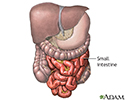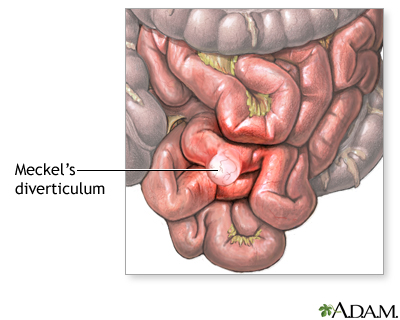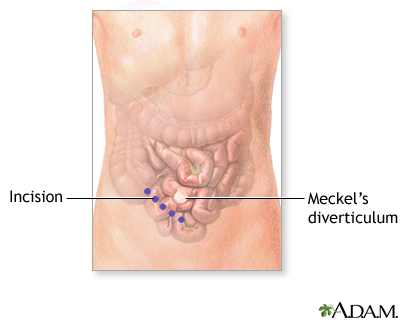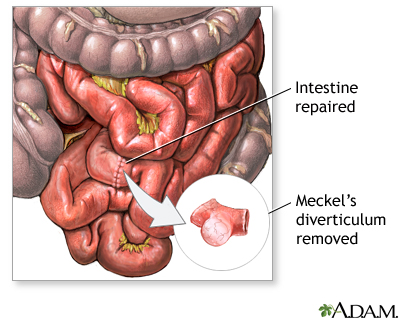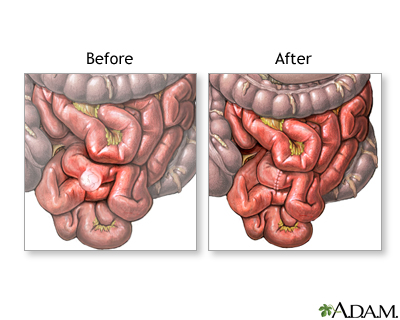Meckel diverticulum
A Meckel diverticulum is a pouch on the wall of the lower part of the small intestine that is present at birth (congenital). The diverticulum may contain tissue similar to that of the stomach or pancreas.
Causes
A Meckel diverticulum is tissue left over from when the baby's digestive tract was forming before birth. A small number of people have a Meckel diverticulum. However, only a few develop symptoms.
Symptoms
Symptoms may include:
- Pain in the abdomen that can be mild or severe
- Blood in the stool
- Nausea and vomiting
Symptoms often occur during the first few years of life. However, they may not start until adulthood.
Exams and Tests
You may have the following tests:
-
Hematocrit
Hematocrit
Hematocrit is a blood test that measures how much of a person's blood is made up of red blood cells. This measurement depends on the number of and s...
 ImageRead Article Now Book Mark Article
ImageRead Article Now Book Mark Article -
Hemoglobin
Hemoglobin
Hemoglobin is a protein in red blood cells that carries oxygen. The hemoglobin test measures how much hemoglobin is in your blood.
 ImageRead Article Now Book Mark Article
ImageRead Article Now Book Mark Article -
Stool smear for invisible blood (
stool occult blood test
)
Stool occult blood test
The stool guaiac test looks for hidden (occult) blood in a stool sample. It can find blood even if you cannot see it yourself. It is the most commo...
 ImageRead Article Now Book Mark Article
ImageRead Article Now Book Mark Article - CT scan
-
Technetium scan
(also called a Meckel scan)
Technetium scan
A liver scan uses a radioactive material to check how well the liver or spleen is working and to assess masses in the liver.
 ImageRead Article Now Book Mark Article
ImageRead Article Now Book Mark Article
Treatment
You may need surgery to remove the diverticulum if bleeding develops. The segment of small intestine that contains the diverticulum is taken out. The ends of the intestine are sewn back together.
You may need to take iron supplements to treat anemia. You may need a blood transfusion if you have a lot of bleeding,
Outlook (Prognosis)
Most people recover fully from surgery and will not have the problem come back. Complications from the surgery are also unlikely.
Possible Complications
Complications may include:
- Excess bleeding (hemorrhage) from the diverticulum
-
Folding of the intestines (
intussusception
), a type of blockage
Intussusception
Intussusception is the sliding of one part of the intestine into another. This article focuses on intussusception in children.
 ImageRead Article Now Book Mark Article
ImageRead Article Now Book Mark Article -
Peritonitis
Peritonitis
Peritonitis is an inflammation (irritation) of the peritoneum. This is the thin tissue that lines the inner wall of the abdomen and covers most of t...
 ImageRead Article Now Book Mark Article
ImageRead Article Now Book Mark Article - Tear (perforation) of the bowel at the diverticulum
When to Contact a Medical Professional
See your health care provider right away if your child passes blood or bloody stool or has ongoing abdominal pain.
References
Bass LM, Wershil BK. Anatomy, histology, embryology, and developmental anomalies of the small and large intestine. In: Feldman M, Friedman LS, Brandt LJ, eds. Sleisenger and Fordtran's Gastrointestinal and Liver Disease . 10th ed. Philadelphia, PA: Elsevier Saunders; 2016:chap 98.
Kleigman RM, Stanton BF, St. Geme JW, Schor NF. Intestinal duplications, meckel diverticulum, and other remnants of the omphalomesenteric duct. In: Kliegman RM, Stanton BF, St. Geme JW, Schor NF, eds. Nelson Textbook of Pediatrics . 20th ed. Philadelphia, PA: Elsevier; 2016:chap 331.
-
Digestive system - illustration
The esophagus, stomach, large and small intestine, aided by the liver, gallbladder and pancreas convert the nutritive components of food into energy and break down the non-nutritive components into waste to be excreted.
Digestive system
illustration
-
Digestive system organs - illustration
The digestive system organs in the abdominal cavity include the liver, gallbladder, stomach, small intestine and large intestine.
Digestive system organs
illustration
-
Meckel's diverticulectomy - series
Presentation
-
Digestive system - illustration
The esophagus, stomach, large and small intestine, aided by the liver, gallbladder and pancreas convert the nutritive components of food into energy and break down the non-nutritive components into waste to be excreted.
Digestive system
illustration
-
Digestive system organs - illustration
The digestive system organs in the abdominal cavity include the liver, gallbladder, stomach, small intestine and large intestine.
Digestive system organs
illustration
-
Meckel's diverticulectomy - series
Presentation
Review Date: 8/20/2016
Reviewed By: Michael M. Phillips, MD, Clinical Professor of Medicine, The George Washington University School of Medicine, Washington, DC. Also reviewed by David Zieve, MD, MHA, Isla Ogilvie, PhD, and the A.D.A.M. Editorial team.



